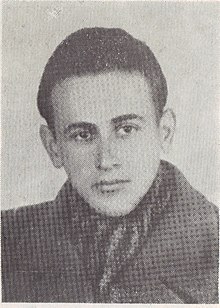History of the Jews in Chernivtsi

The story of the Jews in Chernivtsi is a description of Jewish life in today's Chernivtsi in Ukraine . In Chernivtsi were u. a. the Jewish writers Itzig Manger , Rose Ausländer and Paul Celan were born.
Austrian Empire
Since 1775 Chernivtsi belonged to the Habsburg monarchy . In 1787 there were 74 Jews (houses).
In 1849 Chernivtsi became the capital of the crown land of Bukovina . In 1866 the new Jewish cemetery was laid out. Since 1867, Jews had full equality in the city. In the following decades they provided mayors, rectors and other important personalities of the city. The Franz Joseph University was opened in 1875, and there were also Jewish students and nine student associations as well as teachers and rectors. The large synagogue was inaugurated in 1877 .
Most of the Jews spoke German , partly also Yiddish as a colloquial language. In 1908 the Chernivtsi Conference took place, which was supposed to promote the Yiddish language. In 1910 the Jewish sports club Hakoah Chernivtsi was founded.
Romania
Since 1919 Chernivtsi belonged to Romania. During this time, Jewish cultural life flourished in Chernivtsi.
In 1940 the city was occupied by the Soviet Union. Many Jews were deported to Siberia.
In 1941 the city was conquered by Romania. The Chernivtsi ghetto was established with 50,000 Jews from all over Bukovina. Two thirds were deported to Transnistria and killed there. 20,000 Jews were saved.
Ukrainian SSR
After 1944, Chernivtsi became a place from which many Jews emigrated to Palestine.
In 1989, 5.9% of the population were Jews. After the political change in Europe, a large part of them emigrated again to Israel or the USA.
Ukraine
In 2001 a synagogue was inaugurated on Sadowa uliza. In 2010 the Museum of Jewish History and Culture of Bukovina opened in the former Jewish National House.
Population development
| Jewish population | |||||||
| year | Ges.-Bev. | Jews | proportion of | ||||
|---|---|---|---|---|---|---|---|
| 1857 | 22,000 | 4,678 | 21.6% | ||||
| 1869 | 34,000 | 9,552 | 28.2% | ||||
| 1880 | 46,000 | 14,449 | 31.7% | ||||
| 1890 | 54,000 | 17,359 | 32.0% | ||||
| 1900 | 68,000 | 21,587 | 31.9% | ||||
| 1910 | 87,000 | 28,613 | 32.8% | ||||
Personalities
- Benno Strauch (1854–1940), politician
- Salomon Wininger (1877–1968), author of the Great Jewish National Biography
- Elieser Steinbarg (1880–1932), Yiddish writer
- Mosche Altman (1890–1981), Yiddish writer
- Arthur Kolnik (1890–1972), expressionist graphic artist
- Rose Ausländer (1901–1988), German-speaking poet
- Itzig Manger (1901–1969), Yiddish writer
- Joseph Schmidt (1904–1942), famous opera singer (tenor)
- Josef Burg (writer) (1912–2009), Yiddish writer
- Paul Celan (1920–1970), German-speaking poet
- Selma Meerbaum-Eisinger (1924–1942), German-speaking poet
- Aharon Appelfeld (1932-2018), Israeli writer
- David Vyssoki (born 1948), psychiatrist
- Mila Kunis (* 1983), American actress
- Dimitri Chpakov (* 1989), German rapper, known as SpongeBOZZ and Sun Diego
See also
literature
- Gregor Gatscher-Riedl: imperial and imperial place of longing Czernowitz: "Little Vienna" on the eastern edge of the monarchy . Kral-Verlag, Berndorf 2017, ISBN 978-3990246900 .
- Gregor Gatscher-Riedl: Student life in "Jerusalem am Pruth". The Jewish university connections in Chernivtsi . In: DAVID. Jewish cultural magazine, vol. 29, No. 114, Rosh Haschanah 5778 (Vienna, September 2017), 72–76.
- Andrei Corbea-Hoișie (ed.): Jüdisches Städtebild Czernowitz . Frankfurt 1998.
- Gertrud Ranner; Axel Halling; Anja Fiedler (Ed.): ... "and it makes my heart heavy". Czernowitz Jews remember. German Cultural Forum for Eastern Europe V., Potsdam 2009, ISBN 978-3-936168-28-0 .
- Marianne Hirsch , Leo Spitzer : Ghosts of Home: The Afterlife of Czernowitz in Jewish Memory . University of California Press, 2010
- Hermann Sternberg: On the history of the Jews in Czernowitz , Tel Aviv 1962. Partial print from: Hugo Gold (Hrsg.): History of the Jews in Bukowina . A compilation, 2 volumes. Olamenu, Tel Aviv 1958/1962 (Vol. 1, until 1919, with 172 pages; Vol. 2 1919–1944 with 230 pages)
Remarks
- ^ Results of the censuses of the KK Statistische Central -ommission u. a., in: Anson Rabinbach : The Migration of Galician Jews to Vienna. Austrian History Yearbook, Volume XI, Berghahn Books / Rice University Press, Houston 1975, pp. 46/47 (Table III)



